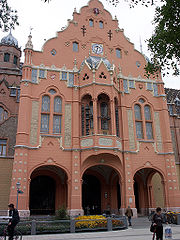.gif)
City Hall (Kecskemét)
Encyclopedia

Kecskemét
Kecskemét is a city in the central part of Hungary. It is the 8th largest city of the country, and the county seat of Bács-Kiskun.Kecskemét lies halfway between the capital Budapest and the country's third-largest city, Szeged, 86 kilometres from both of them and almost equal distance from the two...
, Bács-Kiskun
Bács-Kiskun
Bács-Kiskun is a county located in southern Hungary. It was created as a result of World War II, merging the pre war Bács-Bodrog and the southern parts of Pest-Pilis-Solt-Kiskun counties. With an area of 8,445 km2, Bács-Kiskun is the largest county in the country. The terrain is mostly flat...
County, Hungary
Hungary
Hungary , officially the Republic of Hungary , is a landlocked country in Central Europe. It is situated in the Carpathian Basin and is bordered by Slovakia to the north, Ukraine and Romania to the east, Serbia and Croatia to the south, Slovenia to the southwest and Austria to the west. The...
. It was built in 1893.
The building was designed by Ödön Lechner
Ödön Lechner
Ödön Lechner was a Hungarian architect, nicknamed the "Hungarian Gaudí".Lechner was one of the early representatives of the Hungarian Secession movement, called szecesszió in Hungarian, which was related to Art Nouveau and Jugendstil in the rest of Europe...
and Gyula Pártos
Gyula Pártos
Gyula Pártos was a Hungarian architect. Together with Ödön Lechner he designed a number of buildings in the typical Secession style of the turn of the century Hungary.-Career:...
. The decoration of the building, which consists of Zsolnay
Zsolnay
Zsolnay, or formally Zsolnay Porcelánmanufaktúra Zrt is a Hungarian manufacturer of porcelain, pottery, ceramics, tiles, and stoneware...
tile patterns inspired by old Magyar and Turkic
Turkic peoples
The Turkic peoples are peoples residing in northern, central and western Asia, southern Siberia and northwestern China and parts of eastern Europe. They speak languages belonging to the Turkic language family. They share, to varying degrees, certain cultural traits and historical backgrounds...
folk art, was the start of the National Romanticism movement, which culminated in the Museum of Applied Arts
Museum of Applied Arts (Budapest)
The Museum of Applied Arts is a museum in Budapest, Hungary. This Art Nouveau building was built between 1893 and 1896 to the plans of Ödön Lechner and Gyula Pártos...
in Budapest
Budapest
Budapest is the capital of Hungary. As the largest city of Hungary, it is the country's principal political, cultural, commercial, industrial, and transportation centre. In 2011, Budapest had 1,733,685 inhabitants, down from its 1989 peak of 2,113,645 due to suburbanization. The Budapest Commuter...
.
The building itself is more of a mixture between renaissance
Renaissance
The Renaissance was a cultural movement that spanned roughly the 14th to the 17th century, beginning in Italy in the Late Middle Ages and later spreading to the rest of Europe. The term is also used more loosely to refer to the historical era, but since the changes of the Renaissance were not...
and baroque
Baroque
The Baroque is a period and the style that used exaggerated motion and clear, easily interpreted detail to produce drama, tension, exuberance, and grandeur in sculpture, painting, literature, dance, and music...
styles, for which it has been criticized by National Romanticists like Károly Kós
Károly Kós
Károly Kós was a Hungarian architect, writer, illustrator, ethnologist and politician of Austria-Hungary and Romania.- Biography :...
.
Bertalan Székely
Bertalan Székely
Bertalan Székely was a Hungarian Romantic painter of historical themes. "The Discovery of Louis II's Dead Body", "Women of Eger", "Battle of Mohács", "Ladislas V" are among the most important of his historical paintings. Szekely is also known for his many murals.-External links:* *...
, who also decorated the interior of the Matthias Church
Matthias Church
Matthias Church is a church located in Budapest, Hungary, at the heart of Buda's Castle District. According to church tradition, it was originally built in Romanesque style in 1015. The current building was constructed in the florid late Gothic style in the second half of the 14th century and was...
in Budapest, painted gilded murals on the interior of the Grand Hall.

